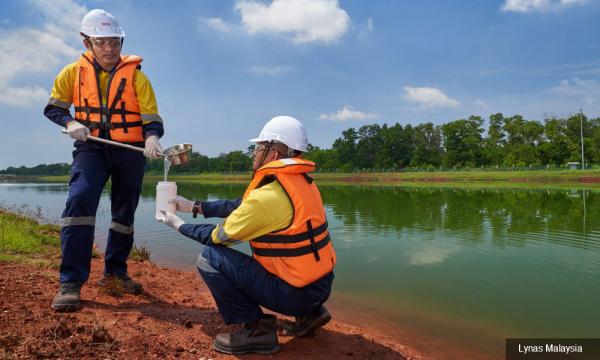On 29 May, YB Wong Tack, Member of Parliament for Bentong issued a press statement regarding Lynas. As he has been reluctant to meet me personally to discuss his views, I am issuing the following response.
YB Wong criticised my statements to the media about Lynas as “highly unethical and deplorable”. Part of my job is to support Australian investors in Malaysia, including when they face market access issues. Malaysia’s diplomats overseas do the same.
Every statement I have made concerning Lynas has been carefully considered and accurate. When I see false or misleading statements by others, I reserve the right to correct the record, as I am doing now.
In his press statement, YB Wong asserted that removing all waste from Malaysia was a “legally binding, black and white agreement undersigned by Lynas”. That is not correct.
As YB Wong knows, Lynas Malaysia produces two solid residues: WLP and NUF. WLP has very low level radioactivity and NUF is not a radioactive material. WLP is a naturally occurring radioactive material and it is approximately one third of the residues by volume.

When Lynas was invited by the Malaysian Government to build its processing facility in Malaysia, it was licensed to explore three options for WLP in the following order of priority: (i) commercial re-use; (ii) permanent storage; or, if (i) and (ii) fail, (iii) removal.
Since then, several Malaysian public universities have done research, and had it peer reviewed, on re-use of the nutrient-rich Lynas Malaysia residues in an agricultural fertiliser.
Re-use would be in line with best practice recommendations previously made by the International Atomic Energy Agency. If this was approved by Malaysian regulators, it would replace some of the 357,531 tonnes of phosphate fertiliser that Malaysia imports from overseas every year.
Interestingly, these expensive imported fertilisers have a similar chemical composition to the Lynas residues AND a similar low level of naturally occurring radioactivity. (Nearly every substance on earth contains some level of radioactivity; it is the amount that is important.)
The second option, which is permanent storage, is the one recommended by the Executive Review Committee appointed last year by MESTECC Minister YB Yeo Bee Yin. Permanent storage is how Malaysia deals with other mildly radioactive residues, such as tin tailings.
The third option – complete removal – is likely to be the most difficult to achieve. International best practice is that the residues of industrial processing are managed in the country where the processing takes place. For example, countries that import Malaysian oil do not ask to return the oil sludge and scale to Malaysia (these by-products can be ten times more radioactive than the Lynas residues). Malaysian rubber and bauxite wastes don’t come back either. Australia has made it clear that it will not be importing residues from Malaysian processing.

YB Wong made several other assertions about Malaysian law that need correction or clarification:
- He says that the law requires such waste to not be located in areas prone to natural disasters, and that Lynas is in a flood-prone area. It is not. In any case, Lynas has told the Government it is happy to move the WLP residue into an offsite permanent disposal facility (PDF) if the Malaysian federal regulators approve the PDF option. The Pahang State Government has given its consent to a PDF being located in Pahang;
- YB Wong states that the law limits the amount of scheduled waste (such as NUF) that can be stored onsite to 20 metric tonnes, and for no more than 180 days. He forgets to mention that the same law allows for extensions, which have been granted, including under the Pakatan Harapan Government, while the permanent solution for NUF is finalised; and
- YB Wong also states that the law requires scheduled wastes to be kept in fully-covered containers, and also that they must be properly quantified, contained and labelled with the dates the wastes are produced. When I last visited the plant, it complied with all regulatory requirements for the storage of scheduled waste. Numerous government audits have confirmed this, as did the Executive Review Committee report issued on 4 December 2018. I’m sure Lynas would be happy to show the Member for Bentong around the site.
In his press statement, YB Wong informs me that Malaysians love their land and their children, so Australia should not “dump onto our land things that Australia doesn’t want”. In fact, the Australian State Government of the day wanted Lynas to build its plant in Western Australia. They were disappointed when Lynas chose Malaysia instead.
Now, in response to the statement by Prime Minister Mahathir on 5 April 2019, Lynas is in talks with the Western Australian (WA) Government about building a cracking and leaching plant in WA that would do the upstream processing in Australia, so that the material going to Malaysia would no longer be radioactive material. That will mean more jobs staying in Australia.
On 20 May, Lynas also announced its plans to build a rare earths processing facility in Texas.
Australia and the US are both developed countries. Rare earths are essential for a range of hi-tech 21st century products, from mobile phones to electric cars to wind turbines. Both Australia and the US want to be part of this future rare earths supply chain, without compromising on environmental safety.
Malaysia should want the same. The way forward is clear.
ANDREW GOLEDZINOWSKI is Australian High Commissioner to Malaysia.
The views expressed here are those of the author/contributor and do not necessarily represent the views of Malaysiakini.

